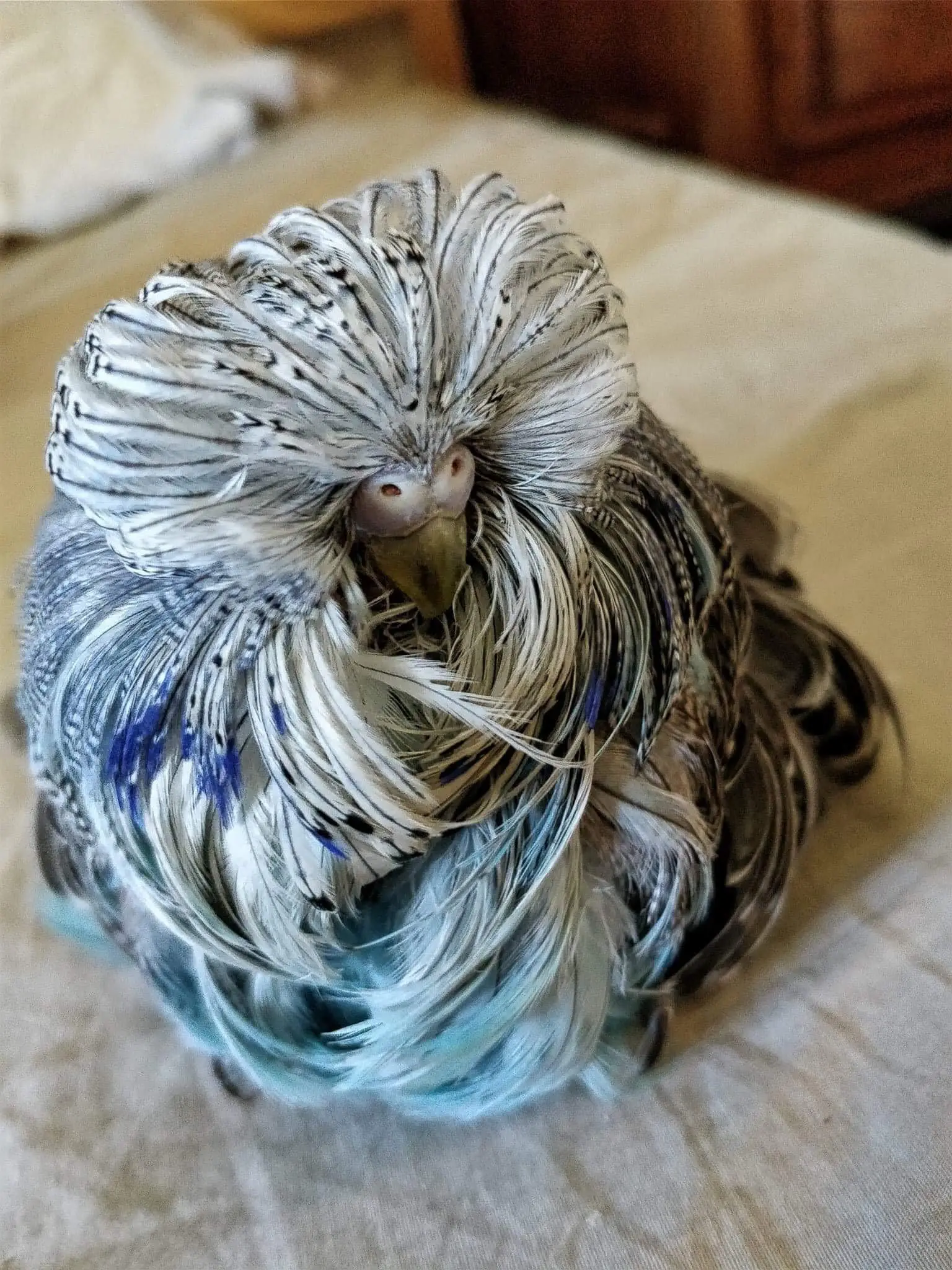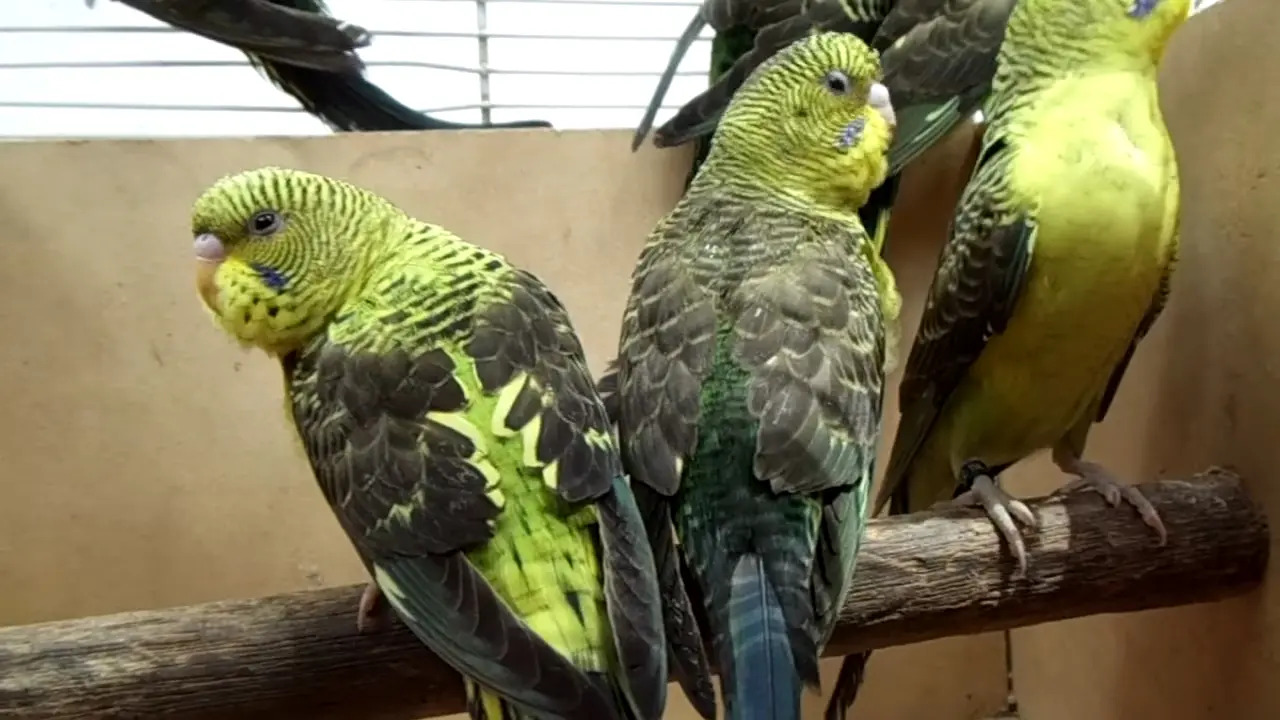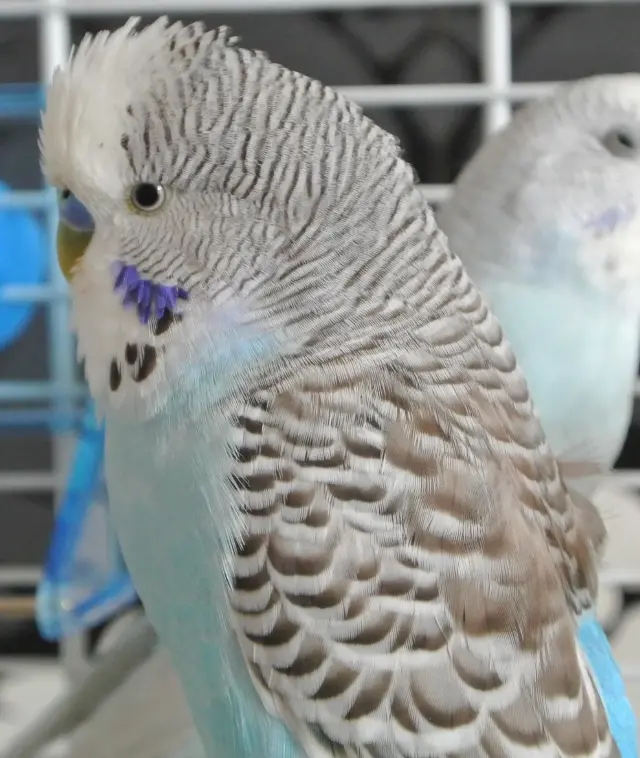Today, there are at least 32 budgerigar mutations are known, including non-rare and rare budgerigar mutations.
In addition, it becomes even rarer that budgie mutations that are already rare or difficult to coexist with are found in a single budgie.
1. Black-faced Budgies

Blackface budgies are currently known and considered to be the rarest budgies. Also, these are fairly new budgies.
Blackface budgies have a recessive mutation that is called “Blackface”. That means a baby budgie needs to get blackface genes from both parents to be a blackface budgie.
Normally, baby budgies lose their forehead stripes later. Blackface budgies keep their forehead black stripes after babyhood.
In addition, after the first molting season, the black lines on the body feathers are slightly noticeable and do not disappear completely.
They also have darker feet. Apart from that, all other body parts such as beak, eyes, and cere are similar to normal budgerigars.
2. Anthracite Budgies

Anthracite budgies are one of the rarest budgies due to their mutation. They get their name from their mutation, which is called anthracite mutation.
The body markings, cheek patches, throat spots, and head stripes are usually black. Besides, the anthracite color is equally spread to the body feathers such as the body, back, chest, flanks, and belly.
Budgies owners from worldwide, try to combine the anthracite mutation with other mutations to produce new varieties. Therefore, they show interest in having at least one of the anthracite budgies.
Budgie breeders are always trying to create new varieties by combining mutations. Therefore, a new mutation opens a new door to almost unlimited new combinations and colors.
3. Feather Duster Budgies

Feather duster budgies are also one of the rarest budgies. They have a genetic disorder or syndrome called chrysanthemum feathering. The syndrome makes the feathers grow non-stop.
In addition, they lack the feather parts that hold the parts that make up the feather together.
As a result of that, feather duster budgies can’t fly, and they have problems with eyesight. They also lack vitality most of the time.
Although they are among the rare budgies, no budgie breeder would want to own one.
4. Slate Budgies

Slate budgies are also one of the rarest budgies. They also have a mutation called “Slate”.
The slate mutation is a recessive and sex-linked mutation that is passed on to subsequent generations on the X chromosome.
5. Black Wings Budgies

Black wings budgies are real, and they are currently rare.
There is not enough data to show why they have such black wings.
Most breeders say this is due to selective breeding. Besides, some researchers say that it is caused by an autosomal recessive gene mutation.
6. Hagoromo (Helicopter, Japanese) Budgies

Hagoromo budgies are considered rare budgies. They are also called Japanese or helicopter budgies all over the world.
Hagoromo budgies are produced from crested budgies with special techniques. Most of them have head crests like crested budgies.
They have flower-like back feathers and back frills feathers that make them hagoromo budgies.
7. Fallow Budgies

Fallow budgies have a mutation called “Fallow”. The fallow mutation reduces the black melanin pigmentation.
As a result of that, fallow budgies have pastel-colored feathers and red eyes.
8. Violet Budgies

Violet budgies have a color-changer mutation: Violet mutation. Most of the time, the mutation is called the “Violet factor”.
The violet factor mutation manipulates the body colors of budgies. In other words, there are versions of the body feathers of both green and blue series budgies blended with violet color.
9. Cinnamon Budgies

Cinnamon budgies have the cinnamon gene mutation that changes the black color of the markings to brown color.
10. Crested Budgies

Crested budgies have crest-like head feathers that make them easy to recognize.
There are different types of crested budgies, such as full circular crested, half-circular crested, tufted crested, double-crested, and triple crested.
11. Lacewing Budgies

A lacewing budgie has both ino and cinnamon budgie mutations at the same time. Both ino and cinnamon genes are sex-linked.
The ino gene removes all the markings and body color. But, the cinnamon gene adds a brown color to the markings.
12. Rainbow Budgies

Rainbow budgies don’t have a specific mutation that is transferred to the next generations. A true rainbow budgie is a combination of mutations such as opaline, clearwing (whitewing), and yellow or golden face.
They are gaining popularity quickly, but they are still a rare budgie variety on a world scale.
Out of List: Half-sider Budgies

Without a doubt, half-sider budgies are the rarest budgies that you can see. But, they don’t have a mutation, or they are not mutation combinations.
They have a rare condition called tetragametic chimerism.
The condition occurs naturally and cannot be produced on purpose or in a planned way.

![What is a fallow budgie? [ALL MUTATIONS & VARIETIES]](https://www.petiska.com/wp-content/uploads/2022/03/what-is-a-fallow-budgie-all-mutations-varieties-1647686348-400x300.jpg)

